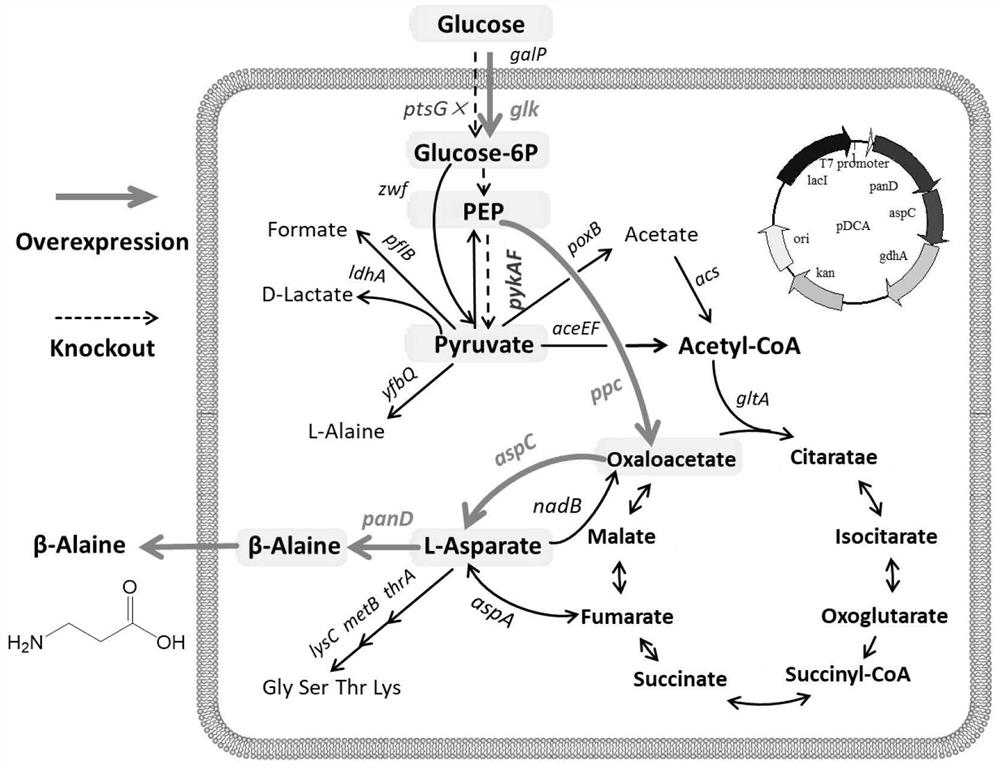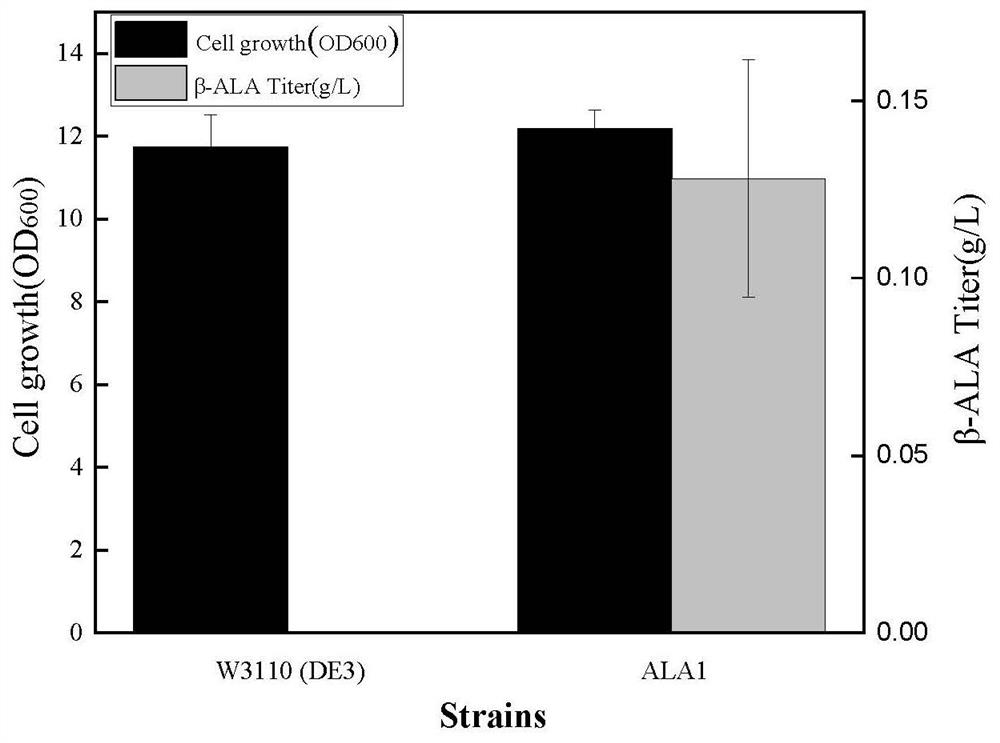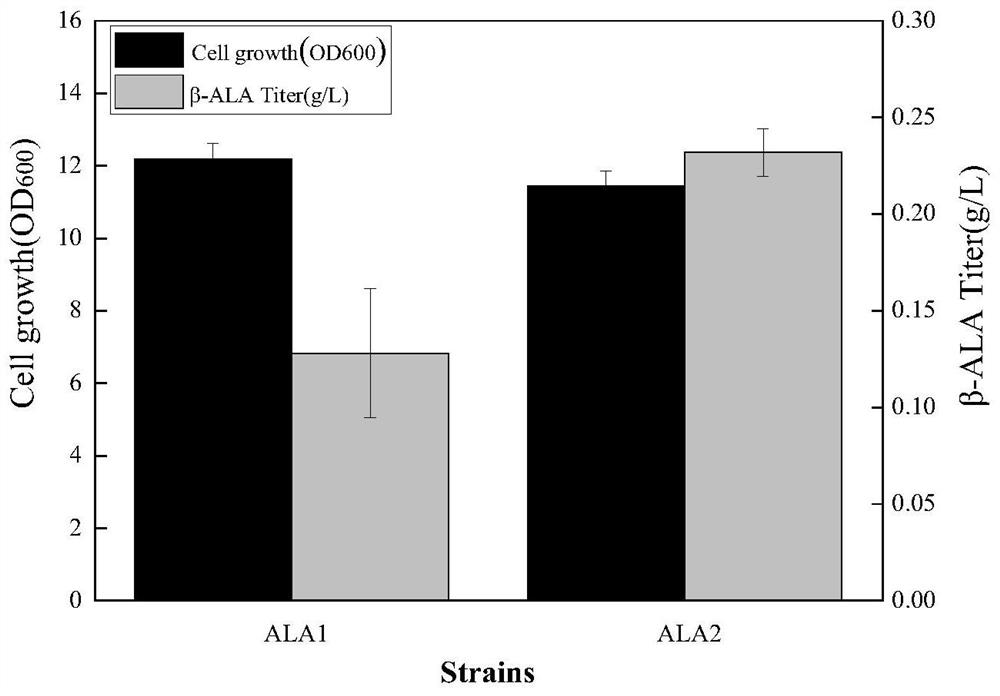Genetically engineered bacterium for high producing beta-alanine and co-culture preparation of D-pantothenic acid
A technology of genetically engineered bacteria and alanine, applied in genetic engineering, plant genetic improvement, bacteria, etc., can solve problems such as complex regulation and suboptimal biological production performance
- Summary
- Abstract
- Description
- Claims
- Application Information
AI Technical Summary
Problems solved by technology
Method used
Image
Examples
Embodiment 1
[0076] Embodiment 1: Determination of D-pantothenic acid content in fermented liquid by HPLC method
[0077] The detection method is as follows:
[0078] Sample treatment: Take 1ml of fermentation broth and centrifuge to get the supernatant, dilute the supernatant with ultrapure water to keep the D-pantothenic acid content between 0.05g / L and 0.40g / L;
[0079] Chromatographic conditions: C 18 Column (250×4.6mm, particle size 5μm, Agilent Technologies Co., Santa Clara, CA, USA), detection wavelength: 200nm, column temperature: 30°C, flow rate: 0.9ml / min;
[0080] Mobile phase: acetonitrile / water / phosphoric acid: (50 / 949 / 1);
[0081] Data collection time: 23min.
Embodiment 2
[0082] Embodiment 2: HPLC method measures beta-alanine content in fermented liquid
[0083] The detection method is as follows:
[0084] Sample treatment: Take 1ml of fermentation broth and centrifuge to get the supernatant, dilute the supernatant with ultrapure water to keep the content of β-alanine between 0.05g / L and 0.50g / L; take 100μL sample and add 1.5mL In the EP tube, add 100 μL of derivatization reagent (2,4-dinitrofluorobenzene) and 100 μL of derivatization buffer (0.5M NaHCO 3 ), then 300 μL of the system was reacted in a 60°C metal bath for 1h15min (400rpm); after the reaction, 700μL of 0.2M PB buffer was added to the system, mixed well, and centrifuged for 12-13min, when precipitation appeared, take 200μL of the supernatant In the lining tube, spare.
[0085] Chromatographic conditions: C 18 Column (250×4.6mm, particle size 5μm, Agilent Technologies Co., Santa Clara, CA, USA), detection wavelength: 360nm, column temperature: 40°C, flow rate: 1ml / min;
[0086] ...
Embodiment 3
[0089] Embodiment 3: Construction and shake flask fermentation of the bacterial strain ALA1 of overexpression panD gene
[0090] Using genetically engineered bacteria E.coli W3110(DE3) (CCTCC NO: M 2018914) as the starting strain, using CRISPR-Cas9-mediated gene editing technology such as figure 1 (Yu Jiang et al.2015Multigene Editing in the Escherichia coli Genome via the CRISPR-Cas9 System.Applied Environmental Microbiology.81:2506-2514), with the Trc promoter derived from pTrc99A (nucleotide sequence shown in SEQ ID No.1 ), to replace the natural promoter of the panD gene in the genome to enhance the expression intensity of the panD gene.
[0091] (1) Construction of pTarget-panD plasmid: use pTarget F plasmid (Addgene Plasmid#62226) as a template, use pT-trc-panD F / pT-trc-panD R as primers for PCR amplification, and the obtained PCR products are subjected to Dpn I in Incubate and digest at 37°C for 3 hours, then transform into E.coli DH5α-transformation-competent medium, ...
PUM
 Login to View More
Login to View More Abstract
Description
Claims
Application Information
 Login to View More
Login to View More - R&D
- Intellectual Property
- Life Sciences
- Materials
- Tech Scout
- Unparalleled Data Quality
- Higher Quality Content
- 60% Fewer Hallucinations
Browse by: Latest US Patents, China's latest patents, Technical Efficacy Thesaurus, Application Domain, Technology Topic, Popular Technical Reports.
© 2025 PatSnap. All rights reserved.Legal|Privacy policy|Modern Slavery Act Transparency Statement|Sitemap|About US| Contact US: help@patsnap.com



